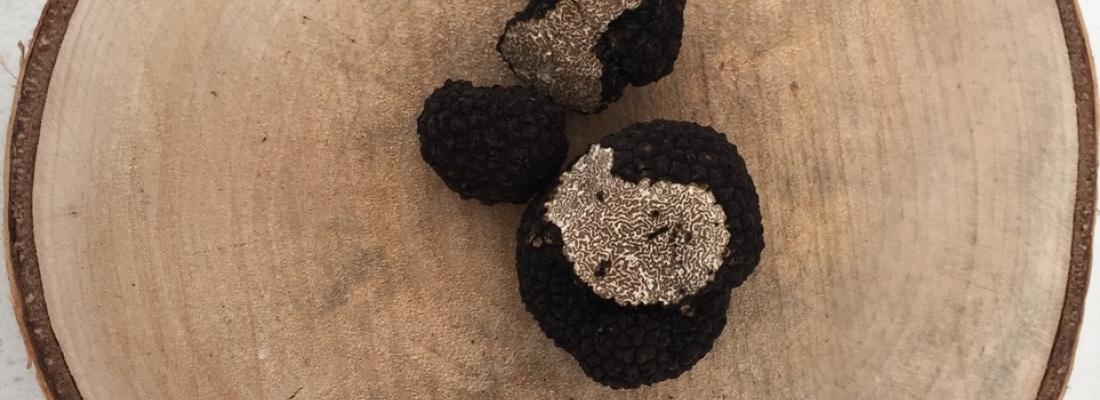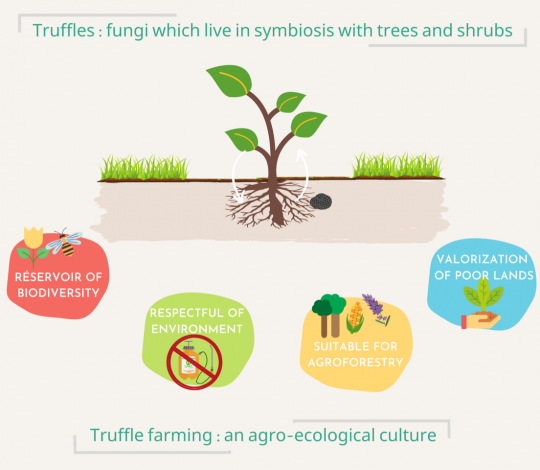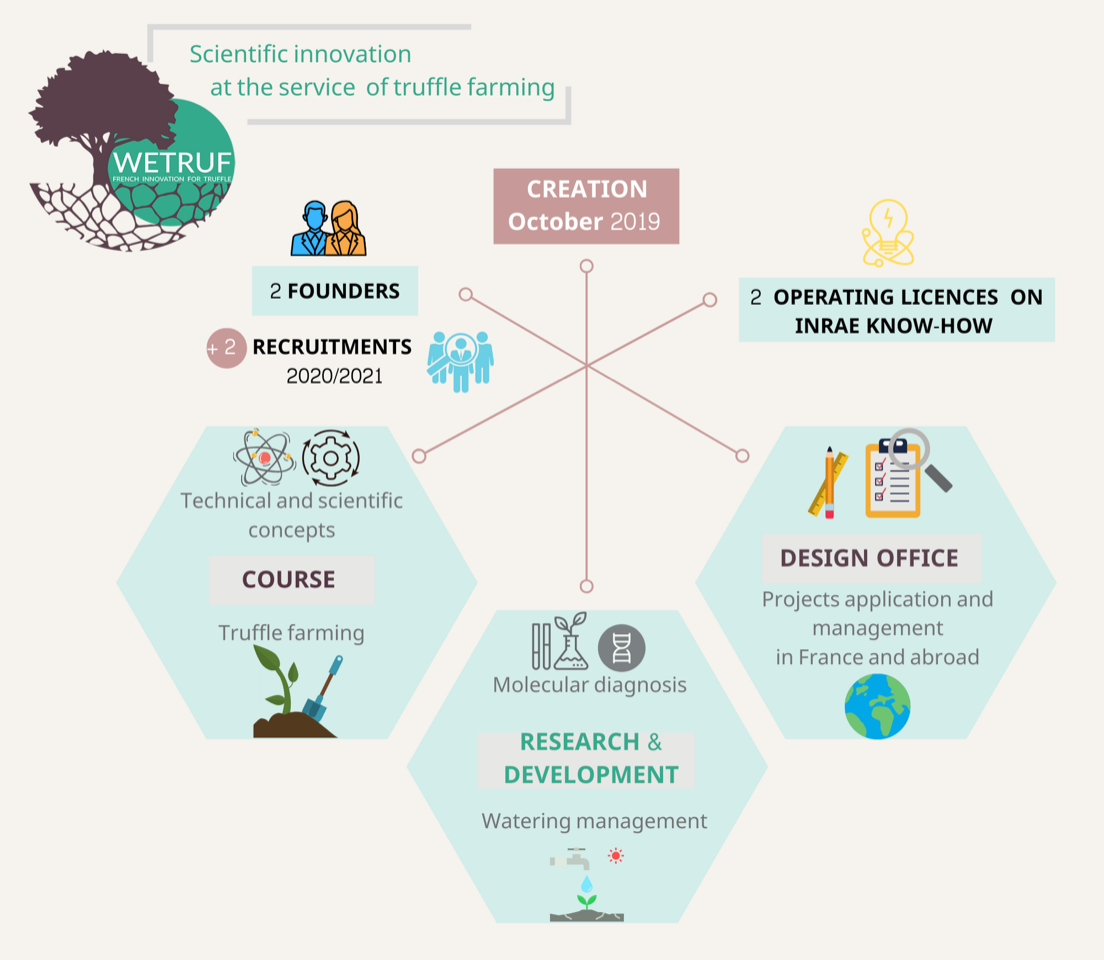Biodiversity Reading time 4 min
WeTruf: the start-up that’s working wonders for truffle growers
Published on 12 October 2020

Truffles are well-known for their fabulous flavours but they can also bring other benefits for farmers. They require no inputs (fertilisers or pesticides), they encourage biodiversity and, now, a new generation of devices are being brought out by the start-up WeTruf, that will make it possible for producers to reduce and fine-tune their watering regimes in real time, according to their needs. Growing truffles is also a good way for farmers to diversify and increase their incomes. Despite these many advantages, though, there is a lack of awareness of truffles as a potential alternative crop and producers often need some help in getting them established.

Flora Todesco spent four years working at INRAE in the Joint Research Unit for Tree/Microorganism Interactions (IAM) with Claude Murat, whose career as a research engineer working on truffles has been a long one. The pair put their combined expertise on truffles and truffle growing to good use in 2019, embarking on a business venture in which Flora became the CEO of WeTruf while Claude provided the necessary scientific support. We caught up with Flora Todesco, now a dynamic business woman, to ask her three questions.
How did the idea of WeTruf come about and what are its goals?
Truffles are mycorrhizal fungi that live symbiotically with tree roots
The idea for WeTruf began in INRAE’s Nancy laboratories, where a multidisciplinary team of biologists and ecologists devote part of their time to the investigation of truffles, mycorrhizal fungi that live symbiotically among tree roots. Research on the cultivation of truffles is not made easy by the fact that it is impossible to create the right conditions for their reproduction in a laboratory. As a result, we can’t just look at the biology of the fungus itself in the lab, we also need in-field testing and cultivation data. It’s now more than 40 years since truffles became a focus for scientists at the IAM laboratory, including experts such as François le Tacon, Francis Martin and, more recently, Claude Murat. We have collected a lot of data on the cultivation of truffles and much innovative work has been carried out. By 2019, the time was right to set up a business to get the benefits of that research out to the truffle-growing industry.
WeTruf has developed two innovative market products. The first helps with water management. A prerequisite for truffle growing, the good water supply required by these fungi is increasingly under threat of disruption from drought. First, at INRAE’s laboratories, a prototype for a water-potential measuring unit1 was developed that used data from probes placed in the soil at the base of the truffle trees to measure directly the availability of water in the soil. WeTruf then perfected the device’s development to turn it into an instrument suitable for sale to the public, the pF Tracer One TM. This device allows us to measure the water available in different soils and locations. Once availability falls below a particular threshold, an alert is triggered to the truffle grower that water is needed. Our second product looks at biomolecular structures. Through a research collaboration between INRAE, AGRITRUFF and ROBIN Seeds, we have created a rapid protocol that allows the user to identify black truffles (Tuber melanosporum), Chinese truffles (Tuber indicum) and European black truffles (Tuber brumale) using a single process. This protocol, which allows many thousands of samples to be tested in just a few days, is being marketed by WeTruf under licence.
DNA tests to identify truffle species
As well as these two new products, we offer a full service to the truffle-growing sector which, despite its fantastic potential for development in France and elsewhere, attracts little capital investment and currently lacks an interprofessional body that would enable it to establish links with the research community. Our offer therefore includes training, provision of expert services, advice, and help in writing up projects or funding bids, etc.

What are your links to INRAE and how did you come to create your start-up?
There are very strong links between INRAE and WeTruf. First, our pioneering products and truffle-growing expertise both started life at INRAE. But we have also continued to work together. Our start-up is hosted by INRAE and we have an agreement to use their laboratories. This is very important for the business as it allows us to carry out the R & D activities needed to bring new products to the market. Last, our scientific consultant, Claude Murat, continues in his work as a research engineer at INRAE’s IAM laboratory. In a more general way, INRAE has always been supportive of our business plans. The start-up was welcomed not only by the Institute’s senior management but also by the truffle industry because it fulfilled a need they had themselves clearly identified. We spent seven months at the Lorrain Incubator in Nancy, which enabled us to take the project forward, creating the service offer and further developing our products. Not least because, among other things, we had to find an industrial partner willing to help us finalise the design of the measuring unit for water potential. And then, in October 2019, WeTruf was launched.
The pF Tracer One TM: a measuring unit for water potentialTM
- For 40 years > a knowledge base on truffles and their cultivation is painstakingly and systematically built up
- 2017 > the first prototype unit to measure water potential is developed
- 2018 > INRAE formally declares its invention
- March 2019 to September 2019 > Incubation at the Incubateur Lorrain in Nancy
- June 2019 > An intellectual property licence agreement is signed
- June 2019 > A marketing licence agreement is signed with INRAE
- October 2019 > WeTruf is launched
- March 2020 > pF Tracer One TM goes on sale for the first time TM
What do you plan to do next?
We are working on two R & D projects linked to our two licences with INRAE. The first is to develop a further model for the water-potential measuring unit that will allow users to access data remotely in real time and will record and display the data on a dashboard. We are also working on a more portable version of the molecular analysis kit so it will be even quicker and easier to use.
Last, this year has seen us embark on an e-learning venture with a series of 13 on-line training modules that cover a range of scientific and technical topics related to truffles and truffle growing.
So there are a lot of good projects in prospect. In truffles we trust.
[1] Supported by the ARBRE LabEx and INRAE’s ECODIV Division
